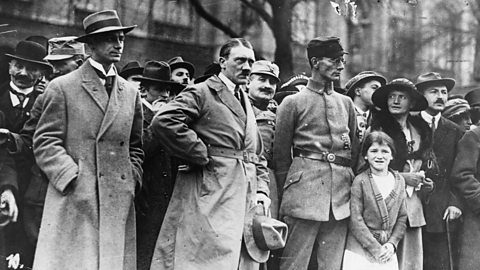The Munich Putsch and the lean years, 1923-1929
The Munich Putsch

In November 1923, Hitler tried to take advantage of the hyperinflationVery rapid and high increase in the level of prices, combined with a fall in the value of money. crisis facing the Weimar government by trying to launch a revolutionRapid and far-reaching change. in Munich â known as the Munich Putsch. It seemed like the perfect opportunity to take power, but poor planning and misjudgement resulted in failure and the subsequent imprisonment of Adolf Hitler.
Causes that led to Hitler attempting the Munich Putsch in 1923
- By 1923, the Nazi party had 55,000 members and was stronger than ever before.
- The Weimar Republic was in crisis due to hyperinflation.
- In September 1923, the Weimar government had called off the general strikeIndustrial action that involves all or most of the main industries in a particular place (city or country)., and German nationalistOne who promotes the independence of their own nation from others. were furious with the government.
- Hitler thought he would be helped by important nationalist politicians in Bavaria.
- Hitler had a huge army of SAAlso known as Storm Troopers or Brown shirts. A military style organisation of the Nazi party formed in 1921 under Hitler. members, but he knew he would lose control of them if he did not give them something to do.
- Hitler hoped to copy Mussolini - the Italian fascistSomeone with extreme right-wing, nationalist views who believes in the idea that there should be a strong, all powerful leader and a one party state. leader - who had come to power in Italy in 1922 by marching on Rome.
Summary of events
During the hyperinflation crisis of 1923, Hitler saw an opportunity. People across the country had many different ideas about how Germany was being run. The individual states had different identities that affected how politics was run in that area. In Bavaria, (capital â Munich) the majority of the population were Catholic and things were quite traditional. This meant that many within that state intensely disliked the new Weimar government and saw them as weak. Hitler thought he would take advantage of this and plotted with two nationalist politicians - Kahr and Lossow - to take over Munich in a revolution.
Hitler collected the SA and told them to be ready to rebel.
But then, on 4 October 1923, Kahr and Lossow called off the rebellion. This was an impossible situation for Hitler, who had 3,000 troops ready to fight.
On the night of 8 November 1923, Hitler and 600 SA members burst into a meeting that Kahr and Lossow were holding at the local Beer Hall. Waving a gun at them, Hitler forced them to agree to rebel - and then let them go home. The SA took over the army headquarters and the offices of the local newspaper.
The next day, 9 November 1923, Hitler and the SA went into Munich on what they thought would be a triumphal march to take power. However, Kahr had called in police and army reinforcements. There was a short scuffle in which the police killed 16 members of the SA.
Hitler fled, but was arrested two days later.
Consequences of the Munich Putsch
The Munich Putsch was a failure in the short term, but it was also an important event in the Nazisâ rise to power. As a result of the Putsch:
Short term failure:
- The Nazi party was banned, and Hitler was prevented from speaking in public until 1927.
- Hitler was tried for high treason (betraying his country) and sentenced to five years in prison.
Long term success:
- He was sentenced in April and out of prison by December. During his time in the comfortable Landsberg Prison, he wrote 'Mein Kampf' â a propaganda book setting out Nazi beliefs. Millions of Germans read it, and Hitler's ideas became very well-known.
- The fact that the judge had been so lenient with the sentence and that Hitler had served so little time suggests that some people in authority had sympathy with Hitler and what he had tried to do.
- Hitler realised that he would never come to power by revolution and that he would have to use democratic means, so he reorganised the party to enable it to take part in elections.
More guides on this topic
- Weimar Germany overview - Edexcel
- The Weimar Republic 1918-1929 - Edexcel
- A History of the Weimar Republic quiz
- Rise of the Nazi Party quiz
- Nazi control and dictatorship 1933-1939 - Edexcel
- Creation of a dictatorship quiz
- Life in Nazi Germany, 1933-1939 - Edexcel
- Women, minorities and living standards in Nazi Germany quiz
- Weimar Germany - exam preparation - Edexcel